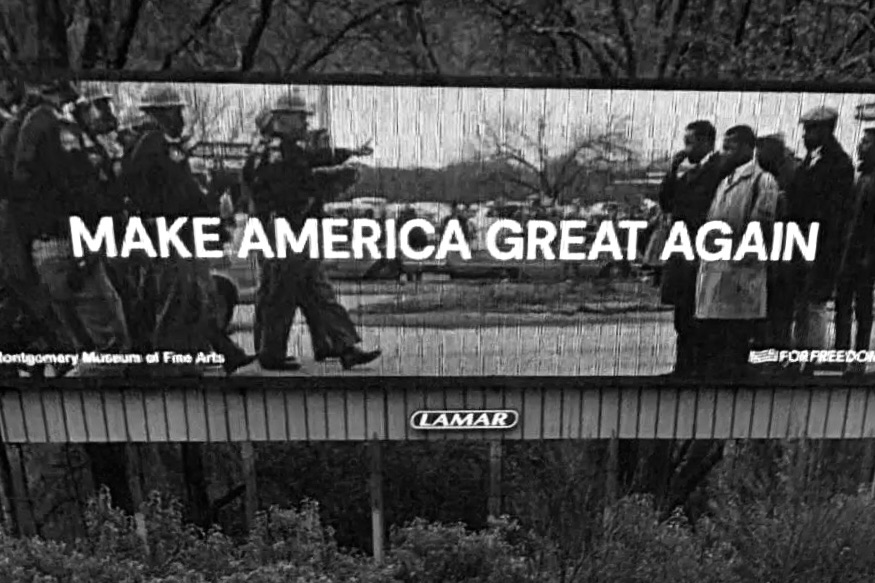MONTGOMERY, Ala. — A billboard juxtaposing a historic photograph from the Selma-to-Montgomery marches with the slogan “Make America Great Again” has been removed following widespread public backlash. The billboard, created by the artist-led group For Freedoms, was taken down after city leadership and the Montgomery Museum of Fine Arts (MMFA) distanced themselves from the project.
The billboard featured an iconic image captured by Spider Martin, the celebrated Alabama photojournalist whose documentation of the 1965 Selma marches played a pivotal role in exposing racial injustice. The photograph depicted Alabama state troopers confronting civil rights leaders John Lewis and Hosea Williams during “Bloody Sunday,” a violent clash that shocked the nation and spurred the passage of the Voting Rights Act of 1965. Martin’s work is widely regarded as a cornerstone of civil rights history, with his photographs housed in institutions like the Smithsonian and the Birmingham Civil Rights Institute.
The controversy erupted when the billboard appeared in Montgomery earlier this month, bearing Spider Martin’s powerful image overlaid with Donald Trump’s “Make America Great Again” slogan. The MMFA’s logo was also displayed on the billboard, leading to confusion about its origins. However, museum officials quickly issued a statement denying involvement, stating that the decision to erect the billboards was made without their approval. They confirmed that the boards were removed immediately after their leadership became aware of them.
The billboard was linked to For Freedoms, an artist collective co-founded by Hank Willis Thomas and Eric Gottesman in 2016. Known for its provocative public art campaigns, For Freedoms often uses historical imagery to spark dialogue about contemporary social issues. The group draws inspiration from Norman Rockwell’s “Four Freedoms” paintings but reimagines them through a modern lens to address topics like racism, inequality, and civic engagement.
Supporters of For Freedoms argue that placing socially conscious art in public spaces—especially billboards—can reach audiences who might not engage with such messages in museums or galleries. Advocates assert that this kind of art belongs in public spaces where it can challenge people who might not otherwise encounter it. However, critics claimed that overlaying a civil rights-era photograph with a polarizing political slogan was inflammatory and out of context.
Art historians noted that anyone familiar with contemporary art would likely recognize this as an intentional provocation meant to inspire reflection rather than offense.
The MMFA clarified that Spider Martin’s photographs will feature prominently in an upcoming exhibition titled Selma Is Now: Civil Rights Photographs by Spider Martin, set to open in late February. The museum emphasized its commitment to presenting Martin’s work in its proper historical context.
The removal of the billboard underscores ongoing tensions between art, politics, and public perception—particularly in Alabama, a state deeply tied to both civil rights history and conservative politics. While some see such works as vital tools for civic engagement, others view them as divisive when placed outside controlled environments like museums.
For Freedoms has faced similar controversies before with its provocative use of public art. Despite mixed reactions, the group continues to push boundaries, using billboards and other nontraditional platforms to spark dialogue on democracy and justice. Whether this approach bridges divides or deepens them remains a matter of debate.

